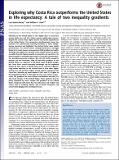Mostrar el registro sencillo del ítem
Exploring why Costa Rica outperforms the United States in life expectancy: A tale of two inequality gradients
| dc.creator | Rosero Bixby, Luis | |
| dc.creator | Dow, William H. | |
| dc.date.accessioned | 2016-12-06T18:56:00Z | |
| dc.date.available | 2016-12-06T18:56:00Z | |
| dc.date.issued | 2016 | |
| dc.identifier.citation | http://www.pnas.org/content/113/5/1130.abstract | |
| dc.identifier.issn | 1091-6490 | |
| dc.identifier.uri | https://hdl.handle.net/10669/29357 | |
| dc.description.abstract | Mortality in the United States is 18% higher than in Costa Rica among adult men and 10% higher among middle-aged women, despite the several times higher income and health expenditures of the United States. This comparison simultaneously shows the potential for substantially lowering mortality in other middle-income countries and highlights the United States’ poor health performance. The United States’ underperformance is strongly linked to its much steeper socioeconomic (SES) gradients in health. Although the highest SES quartile in the United States has better mortality than the highest quartile in Costa Rica, US mortality in its lowest quartile is markedly worse than in Costa Rica’s lowest quartile, providing powerful evidence that the US health inequality patterns are not inevitable. High SES-mortality gradients in the United States are apparent in all broad cause-of-death groups, but Costa Rica’s overall mortality advantage can be explained largely by two causes of death: lung cancer and heart disease. Lung cancer mortality in the United States is four times higher among men and six times higher among women compared with Costa Rica. Mortality by heart disease is 54% and 12% higher in the United States than in Costa Rica for men and women, respectively. SES gradients for heart disease and diabetes mortality are also much steeper in the United States. These patterns may be partly explained by much steeper SES gradients in the United States compared with Costa Rica for behavioral and medical risk factors such as smoking, obesity, lack of health insurance, and uncontrolled dysglycemia and hypertension. | es_ES |
| dc.description.sponsorship | National Institute of Aging/[P30AG012839]/NIA/Estados Unidos | es_ES |
| dc.description.sponsorship | National Institute of Aging/[R01AG031716]/NIA/Estados Unidos | es_ES |
| dc.language.iso | en_US | es_ES |
| dc.source | Proceedings of the National Academy of Sciences (PNAS); Volumen 113, Número 5. 2016 | es_ES |
| dc.subject | Adult Mortality | es_ES |
| dc.subject | Socioeconomic Status | es_ES |
| dc.subject | Costa Rica | es_ES |
| dc.subject | Inequality | es_ES |
| dc.subject | United States | es_ES |
| dc.title | Exploring why Costa Rica outperforms the United States in life expectancy: A tale of two inequality gradients | es_ES |
| dc.type | artículo original | |
| dc.identifier.doi | 10.1073/pnas.1521917112 | |
| dc.description.procedence | UCR::Vicerrectoría de Investigación::Unidades de Investigación::Ciencias Sociales::Centro Centroamericano de Población (CCP) | es_ES |


